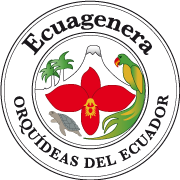Telipogon humboldtiana, named in honor of the German naturalist and explorer, Alexander von Humboldt.
Four species of orchids new to science pay homage to Alexander von Humboldt and his expeditionaries.
The plants discovered by ECUAGÉNERA in 2019 come from the provinces of Azuay, Morona Santiago and Zamora Chinchipe. In field explorations, researchers of this company collected the orchids and cultivated them in the greenhouses of Gualaceo, where they determined that they were unknown.
The orchids in question are Telipogon humboldtiana, Caucaea kunthiana, Dichaea bonplandiana and Telipogon montufariana, named in honor of Alexander von Humboldt, Karl Kunth, Aimé Bompland and Carlos de Montúfar (Ecuadorian).
ECUAGENERA permanently carries out research work to contribute to science with the publication of new species. It also intervenes in hybridization processes to improve plant genetics and satisfy the needs of orchid lovers.
Telipogon montufariana, cultivated at ECUAGENERA, named after the Ecuadorian Carlos de Montufar.
Research carried out by ECUAGENERA experts has shown that the Telipogon genus presents certain difficulties when cultivated ex situ, since most of them come from the Andean region, around 3,000 meters above sea level.
In addition, it has been determined that endemism prevails in Telipogon. In their habitat they enjoy high environmental humidity, which is close to 100%. On the other hand, they do not tolerate being wet for a long time, because the roots are attached to thin branches, where rain evaporates in a short period of time. For this reason, they hardly adapt to nursery cultivation.
“Other orchid species of the same subtribe need to dry completely for a few hours, while in the case of Telipogon, this causes dehydration. It is a bit complex to generate the same habitat-like culture requirements. This is one of the reasons for the complexity of their cultivation”, mentions José Portilla, executive president of Ecuagénera.
On the other hand, in the Caucaea genus, which also comes from cold climates, ex situ cultivation is easier. The same happens with the Dichaea genus, which comes from the Amazon and grows in warm to intermediate climates, with abundant humidity.
Dichaea bonplandiana, by the French botanist Aimé Bompland.
For the cultivation of the different orchids, ECUAGENERA standardizes the processes. To do so, it uses chopped pine bark in different sizes, according to the species and size of the plants.
Caucaea kunthiana, by German naturalist Karl Kunth.
“Sometimes they are mixed with pumice rock to achieve more aeration in the roots, because this rock is light and porous. Therefore, it contains a lot of oxygen,” adds Portilla (I).







